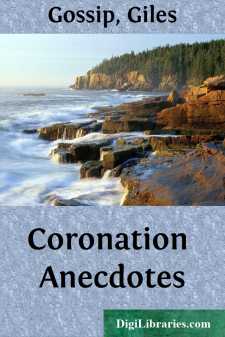Categories
- Antiques & Collectibles 13
- Architecture 36
- Art 48
- Bibles 22
- Biography & Autobiography 813
- Body, Mind & Spirit 142
- Business & Economics 28
- Children's Books 17
- Children's Fiction 14
- Computers 4
- Cooking 94
- Crafts & Hobbies 4
- Drama 346
- Education 46
- Family & Relationships 57
- Fiction 11829
- Games 19
- Gardening 17
- Health & Fitness 34
- History 1377
- House & Home 1
- Humor 147
- Juvenile Fiction 1873
- Juvenile Nonfiction 202
- Language Arts & Disciplines 88
- Law 16
- Literary Collections 686
- Literary Criticism 179
- Mathematics 13
- Medical 41
- Music 40
- Nature 179
- Non-Classifiable 1768
- Performing Arts 7
- Periodicals 1453
- Philosophy 64
- Photography 2
- Poetry 896
- Political Science 203
- Psychology 42
- Reference 154
- Religion 513
- Science 126
- Self-Help 84
- Social Science 81
- Sports & Recreation 34
- Study Aids 3
- Technology & Engineering 59
- Transportation 23
- Travel 463
- True Crime 29
Coronation Anecdotes
by: Giles Gossip
Categories:
Description:
Excerpt
§ 1. ANECDOTES OF THE REGALIA AND ROYAL VESTMENTS.
"History—the picture of man—has shared the fate of its original. It has had its infancy of Fable; its youth of Poetry; its manhood of Thought, Intelligence, and Reflection."—Anon.
No. 1. The Regal Chair.
The Regalia of England are the symbols of a monarchical authority that has been transmitted by coronation ceremonies for upwards of ten centuries. But the incorporation of England, Scotland, and Ireland, into one united kingdom,—an event peculiar to the coronation of George IV, to have recognised,—has connected the history of the Imperial Regalia with some tales of legendary lore, the truth of which, if this circumstance does not demonstrate, be assured, gentle reader, nothing will. Irish records are said to add at least another thousand years of substantial history to the honours of that solid regal seat, or coronation chair, in which our monarchs are both anointed and crowned: while some of our own "honest chroniclers" assign to it a still more marvellous antiquity.
Holinshed gives us the history of one Gathelus, a Greek, who brought from Egypt into Spain the identical stone on which the patriarch Jacob slept and "poured oil" at Luz. He was "the sonne of Cecrops, who builded the citie of Athens;" but having married Scota, the daughter of Pharaoh, he resided for some time in Egypt, from whence he was induced to remove into the West by the judgments pronounced on that country by Moses. In Spain, "having peace with his neighbors, he builded a citie called Brigantia (Compostella)," where he "sat vpon his marble stone, gave lawes, and ministred justice vnto his people, thereby to maintaine them in wealth and quietnesse," And "Hereof it came to passe, that first in Spaine, after in Ireland, and then in Scotland, the kings which ruled over the Scotishmen received the crowne sittinge vpon that stone, vntill the time of Robert the First, king of Scotland." In another part of his "Historie of Scotland," Holinshed mentions king Simon Brech as having transmitted this stone to Ireland, about 700 years before the birth of Christ, and that "the first Fergus" brought it "out of Ireland into Albion," B.C. 330. One important property of this stone should not be unnoticed. It is said, by the writers from whom the foregoing particulars are derived, to furnish a test of legitimate royal descent; yielding an oracular sound when a prince of the true blood is placed upon it, and remaining silent under a mere pretender to the throne. We heard various joyful acclamations on the recent "royal day;" but (perhaps from that very circumstance) could not distinguish the sound in question.
Apart from these legends, the real history of the [Saxon: hag-fail], or Fatal Stone, is curious; and has induced the learned Toland to call it "the antientest respected monument in the world." It is to be traced, on the best authorities, into Ireland; whence it had been brought into Scotland, and had become of great notoriety in Argyleshire, some time before the reign of Kennith, or A.D....


